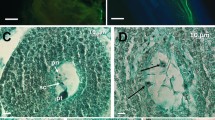Abstract
Interspecific crosses were made between the cultivated sunflower inbred line HA89 and accessions of five wild perennial Helianthus species (H. giganteus L., H. laevigatus T. & G., H. resinosus Small, H. pauciflorus Nutt. and H. decapetalus L.) resistant to broomrape ( Orobanche cernua Loefl.). Using the genetic male-sterile isogenic version of that line as female, successful reciprocal crosses were also obtained with all these wild species except with H. decapetalus. Five-day-old hybrid embryos were excised and cultured in vitro. In all cases, few mature plants were obtained from embryos in early developmental stages (early heart and globular) but up to 28% mature plants were obtained from embryos in later stages of development. Very immature embryos were difficult to excise without damage. Hybrid embryos and mature plants were obtained from all five wild species. Interspecific hybrid embryos from different wild species showed distinct developmental potentials, the proportion of hybrid embryos in different developmental stages varying among species. Differences in the proportion of hybrid embryos at the several developmental stages were also obtained for the reciprocal crosses (cultivated × wild), which showed higher proportion of fully developed embryos. Hybrids involving H. giganteus and cultivated sunflower were difficult to obtain without the use of embryo culture. Embryo culture proved to be an useful tool to overcome post-zygotic hybrid incompatibility in different Helianthus spp., and facilitated interspecific transfer of resistance to O. cernua.
Similar content being viewed by others
References
Alexander, M.P., 1969. Differential staining of aborted and nonaborted pollen. Stain Technol 44: 117–122.
Atlagic, J., 1996. Cytogenetic studies in hexaploid Helianthus species and their F1 hybrids with cultivated sunflower, H. annuus. Plant Breed 115: 257–260.
Chandler, J.M. & B.H. Beard, 1983. Embryo culture of Helianthus hybrids. Crop Sci 23: 1004–1007.
Chandler, J.M., C.C. Jan & B.H. Beard, 1986. Chromosomal differentiation among the annual Helianthus spp. Syst Bot 11: 354–371.
Christov, M., 1991. Possibilities and problems in the hybridization of cultivated sunflower with species of the genus Helianthus L. Helia 15: 35–40.
Denat, J.F., M. Coumans, H. Serieys & R. Jonard, 1991. Definition d'un milieu de culture permettant le developpement d'embryons immatures de tournesol de 3 jours. Application à l'obtention d'hybrides interspecifiques. CR Acad Sci Paris, t. 313, Serie 3: 145–151.
Espinasse, A., C. Lay & C.D. Dybing, 1985. Factors controlling in vitro development of sunflower embryos. Agronomie 5: 825–832.
Espinasse, A., J. Volin, C.D. Dybing & C. Lay, 1991. Embryo rescue through on ovule culture in Helianthus. Crop Sci 31: 102–108.
Feng, Q., H.T. Stalker & H.E. Patee, 1996. Plant recovery of selfs and interspecific hybrids of Arachis by in vitro culture of peg tips. Crop Sci 36: 1660–1666.
Finer, J.J., 1987. Direct somatic embryogenesis and plant regeneration from immature embryos of hybrid sunflower (Helianthus annuus L.) on a high sucrose-containing medium. Plant Cell Rep 6: 372–374.
Gamborg, O.L., R.A. Miller & K. Ojima, 1968. Nutrient requirements of suspension cultures of soybean root cells. Exp Cell Res 50: 151–158.
Georgieva-Todorova, J., 1984. Interspecific hybridization in the genus Helianthus L. Z. Pflanzenzüchtg 93: 265–279.
Heiser, C.B., W.C. Martin & D.M. Smith. 1962. Species crosses in Helianthus. I diploid species. Brittonia 14: 137–147.
Iuoras, M., 1987. FAO sunflower sub-network report 1984–86. pp. 1–15. In: D. Skoric (Ed), Genetic Evaluation of Helianthus Wild Species and Their Use in Breeding Programs. FAO, Szeged, Hungary.
Jan, C.C., 1988. Chromosome doubling of wild x cultivated sun-flower interspecific hybrids and its direct effect on backcross success. In: Proc. Int. Sunflower Conf., 12th, Novi Sad, Yugoslavia. Int. Sunf. Assoc., Paris, France, pp. 287–292.
Jan, C.C., J.M. Chandler & S.A. Wagner, 1988. Induced tetraploid and trisomic production of Helianthus annuus L. Genome 30: 647–651.
Jan, C.C., 1992. Registration of four nuclear male-sterile sunflower genetic stock lines. Crop Sci 32: 1519.
Jan, C.C., 1996. Developing unique interspecific germplasm for sunflower improvement. Biotechnology & wild species. In: Proc. Int. Sunflower Conf., 14th, Beijing-Shenyang, P.R. China. Int. Sunf. Assoc., Paris, France, pp. 1111–1116.
Jan, C.C., 1997. Cytology and interspecific hybridization. In: A.S. Albert (Ed), Sunflower Technology and Production, pp. 497–558. American Society of Agronomy, Madison, Wisconsin.
Kräuter, R., A. Steinmetz & W. Friedt. 1991. Efficient interspecific hybridization in the genus Helianthus via ‘embryo rescue’ and characterization of the hybrids. Theor Appl Genet 82: 521–525.
Laferrière, J.E., 1986. Interspecific hybridization in sunflowers: an illustration of the importance of wild genetic resources in plant breeding. Outlo Agricul 15: 104–129.
Monnier, M., 1976. Culture in vitro de l'embryon immature de Capsella bursa-pastoris Moench. Rev Cyt Biol Veget 39: 1–120.
Newcomb, W., 1973. The development of the embryo sac of sunflower Helianthus annuus after fertilization. Can J Bot 51: 879–890.
Phillips, G.C. & G.B. Collins, 1979. In vitro tissue culture of selected legumes and plant regeneration from callus cultures of red clover. Crop Sci 19: 59–64.
Raghavan, V., 1976. Experimental Embryogenesis in Vascular Plants. Academic Press, New York.
Ruso, J., S. Sukno, J. Domínguez-Giménez, J.M. Melero-Vara & J.M. Fernández-Martínez, 1996. Screening of wild Helianthus species and derived lines for resistance to several populations of Orobanche cernua. Plant Dis 80: 1165–1169.
Seiler, G.J. & L.H. Rieseberg, 1997. Systematics, origin and germplasm resources of the wild and domesticated sunflower. In: A.S. Albert (Ed), Sunflower Technology and Production, pp. 21–26. American Society of Agronomy, Madison, Wisconsin.
Skoric, D., 1992. Achievements and future directions of sunflower breeding. Field Crops Res 30: 231–270.
Stafford, A. & D.R. Davis, 1979. The culture of immature pea embryos. Ann Bot 44: 315–321.
Sukno, S., C.C. Jan, J.M. Melero-Vara & J.M. Fernández-Martínez, 1998. Sunflower interspecific hybrids: reproductive behaviour and broomrape resistance. Plant Breed 118: 279–285.
Thompson, T.E., D.C. Zimmerman & C.E. Rogers. 1981. Wild Helianthus as a genetic resource. Field Crops Res 4: 333–343.
Author information
Authors and Affiliations
Rights and permissions
About this article
Cite this article
Sukno, S., Ruso, J., Jan, C. et al. Interspecific hybridization between sunflower and wild perennial Helianthus species via embryo rescue. Euphytica 106, 69–78 (1999). https://doi.org/10.1023/A:1003524822284
Issue Date:
DOI: https://doi.org/10.1023/A:1003524822284




